Despite the left’s false platitudes that firearms are the cause of the high murder rates in some areas of the US, as if they committed the crimes themselves, a firearm will only ever hit that at which it is aimed. Successful use of a firearm, whether it be in war, sport, or practice depends upon the correct utilization of the sighting system on the weapon, and, in this article, I’ll cover the four basic types of sights, how to properly use them, and the first two steps in firing a shot.
We’ve now covered introductions to pistols, shotguns, and rifles, along with some articles on carrying concealed and safety, so we are now going to move on into actual use of firearms. Although I will continue to delve into types of weapons and even specific guns themselves in articles, further discussion of the tools loses import when there is no discussion of the art. Before we can get into ballistics and in-depth discussion of ammunition, we need to discuss shooting itself.
Firing The Shot
Most novices assume that you simply point the gun at your target and pull the trigger and you will almost always hit him. This isn’t true for stormtroopers in Star Wars, and it fortunately isn’t true for the majority of criminal thugs shooting “gangsta style.”

I primarily teach rifle shooting, and, as it is the area in which I have the most expertise, and most of its lessons can transfer to pistols, we will discuss rifle shooting. The best way to learn to shoot is good instruction from an experienced teacher, and practice using a .22 rifle or other low recoil rifle until the basics are mastered.
Depending on your organization, there are a different number of “steps” in firing a shot, but they all mean the same thing. I will list them here.
- Sight Alignment
- Sight Picture
- Breathing
- Focus
- Squeeze the trigger
- Follow Through
The first four are often lumped together into just Sight Picture, and the last two together are considered Trigger Control. If you have a good sight picture when the shot breaks, and if you have good trigger control, your bullet WILL go where you want it to go, assuming the rifle and ammo are functioning correctly in all areas. We will leave the breathing and focus for the next article, and concentrate today on Sight Alignment and Sight Picture.
Sight Alignment
“But Luke, my sights ARE aligned! See?” a student might comment to me. Yes, assuming you have tightened all the bolts, your scope may be firmly on its rings, or your irons may be properly on the front and back of the sight radius indeed. However, your HEAD is not aligned to the sights, and, unless you do that the right way, the same way, every time, you may miss, even though you saw a good sight picture.
The way you position your head on a rifle stock involves two things, charmingly called “turkey neck” and “cheek weld.” Turkey neck is a reminder for you to extend your neck and get your face close to the sights. If you extend your head to the (comfortable) maximum, you will be consistent.
Note that there is also something called “eye relief.” It is far too common for scopes to be mounted too far back, and a student gets up and close to it, and the recoil gives you a nice ring around your eye. This is called “scoping” and is one reason you should always wear safety glasses. Proper eye relief, which means that the scope is where it needs to be so that it is the proper distance out from your eye when your head is in the right spot on the stock, is essential. More on determining eye relief in a bit.

We’re not looking at anything, but notice how you can see the entire field of view of the scope, this means your eye (or my phone) is at correct eye relief.
Cheek weld is the other method to insure repeatability. You want to tuck that stock under your cheekbone so it is always in the same spot. Your scope may be too high, and often is, as stocks are usually set for irons. You should always put the scope as low as you can on a rifle as long as it will clear. There are riser pads available to adjust “comb height” (which is what this is called) as well as inserts and movable pieces in the better stocks to do it for you.
There are two basic types of sights: irons and optics. Iron sights are made up of a front and a rear sight that you align with your eye to make a combined sight picture. The front sight is typically a blade of some thickness, or a thin blade with a pin on top. The rear sight is either an open V of metal with a notch, or a round disc with a hole through which you look. The former are called “open sights” and the latter are called “peep” or, more properly, “aperture” sights.
Proper alignment of open sights involves centering the blade of the front sight in the notch of the rear sight, with the tops of both sights being equal. For aperture sights, center the top edge of the front sight blade directly across the middle of the aperture.
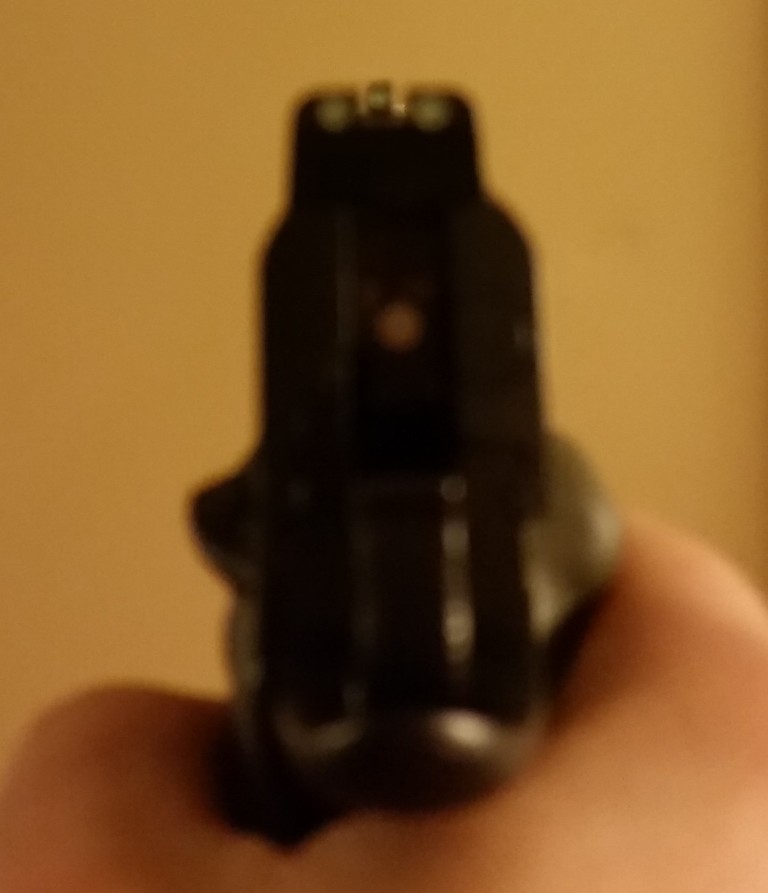
We’re not aiming at anything, but notice how the front sight is in between and level with the rear.
Optics are traditional scopes, red dot scopes, and holographic sights like EOTechs and AimPoints. To get proper sight alignment on a scope, you need to see the reticule in the middle clearly (the crosshairs), and have no blackness anywhere in the optic field. If you have a black ring around the field of view, but you can still see out the middle, you are either too close to the scope, or too far away; move your head. If you see that blackness, but the view is also off to the side, or up or down, you need to move your head in those directions as well.
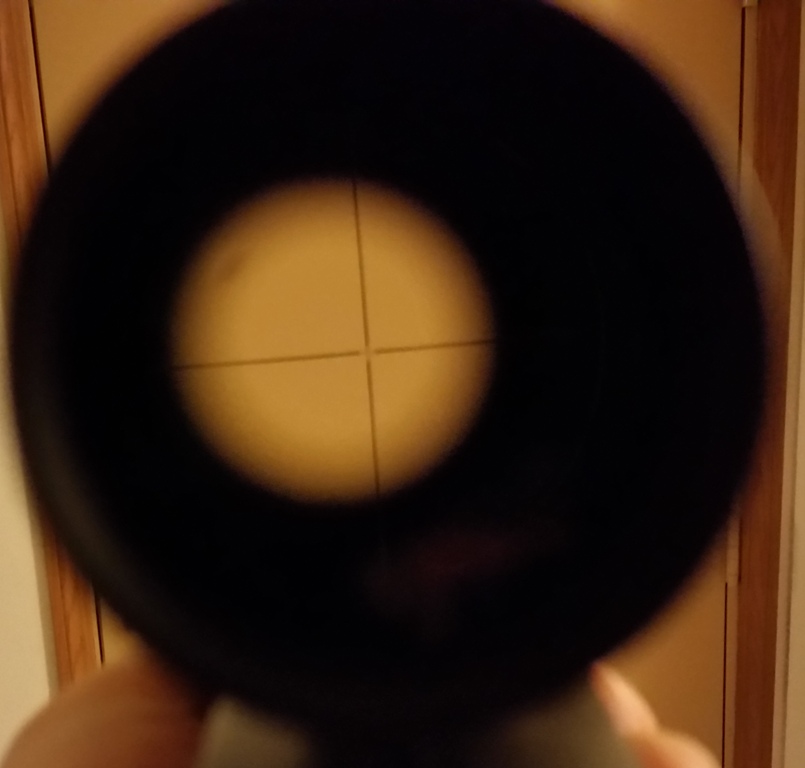
If you see this, you need to move your head either forward or away until you see no black, and also left or right until you center up.
Red dot scopes are the same, but, due to their more “scout” style positioning, you won’t see black around them. The modern holographic reflex sights allow the user to not actually have good sight alignment because the crosshairs moves its reflection with you as you move. These last are fabulous sights, and many professionals use them. I recommend learning on irons, or at least a traditional scope, so that you can master the shooting before you use a reflex sight.
Sight Picture
This is actually easier to describe and do than sight alignment. Once you have your head welded to that stock, and are looking through the sights, you have to point the gun where you want the bullets to go. There are two schools of thought on this, and you should use both at varying times.
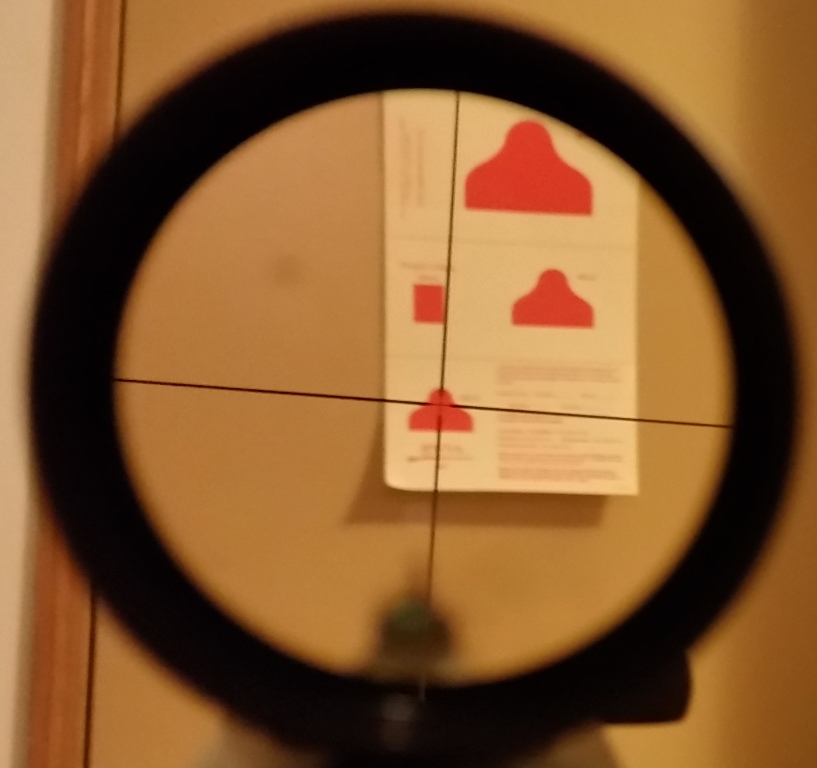
Pardon the tilt. Center hold, with a scope, on small target.
We need four terms here. Point of aim, point of impact, center hold, and 6 o’clock hold. Point of aim is where you are aiming, obviously. Point of impact is where the bullet lands. Ideally, your sights will be set up so that the bullet flies true regarding right and left, and has enough upwards tilt to counteract gravity. (If you truly set your sights zeroed to the barrel, at any range, the bullet would be below it at least some amount due to gravity.)
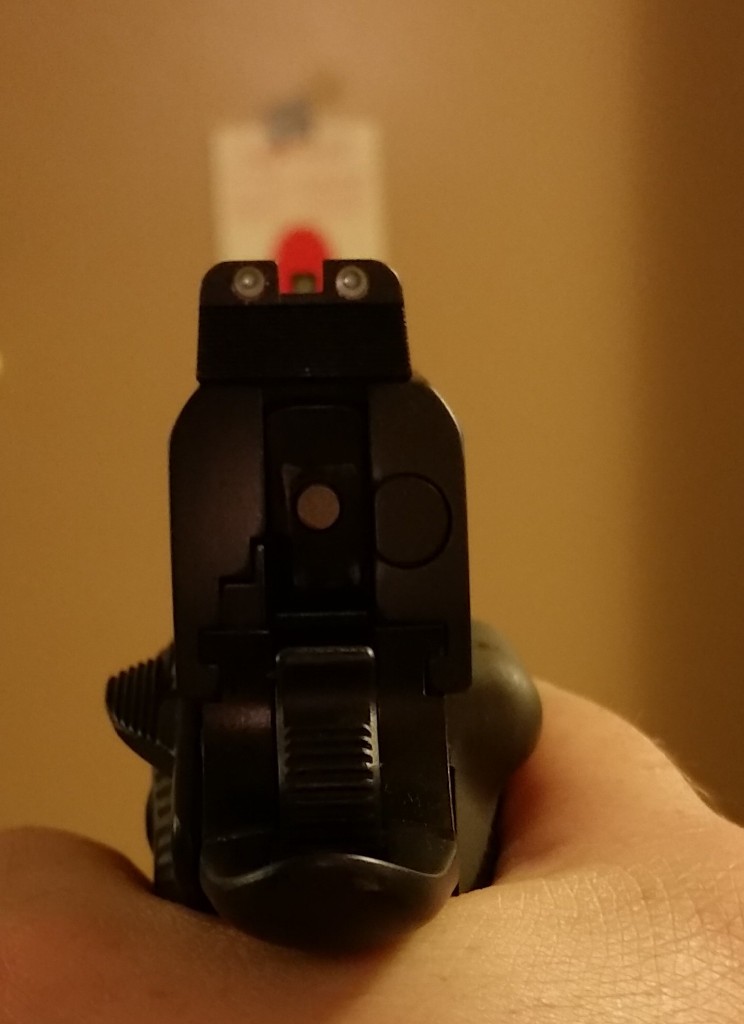
Center Hold on Big Target with Iron Sights.
Here’s the money. Center hold versus 6 o’clock hold. Center hold is best used for scopes. Line those crosshairs dead over the center of the target and let fly. Center hold also works on no-bullshit combat pistols. Center the target up just over the top of the front sight, or right behind it, and let fly.
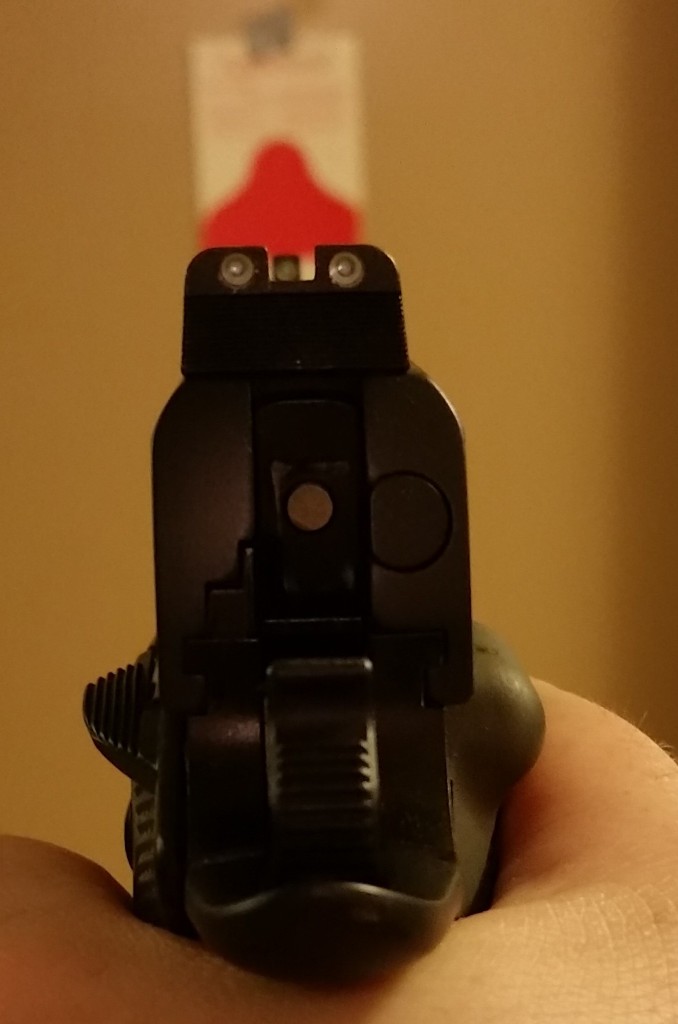
6 o’clock hold on big target.
6 o’clock hold is for precision shooting at range. You set your sights up so that you aim at the base of the target (i.e. 6 o clock on a clock face) and the bullet hits in the middle. You do this so that the blade of the sight does not obscure the target as it raises and lowers due to breathing.
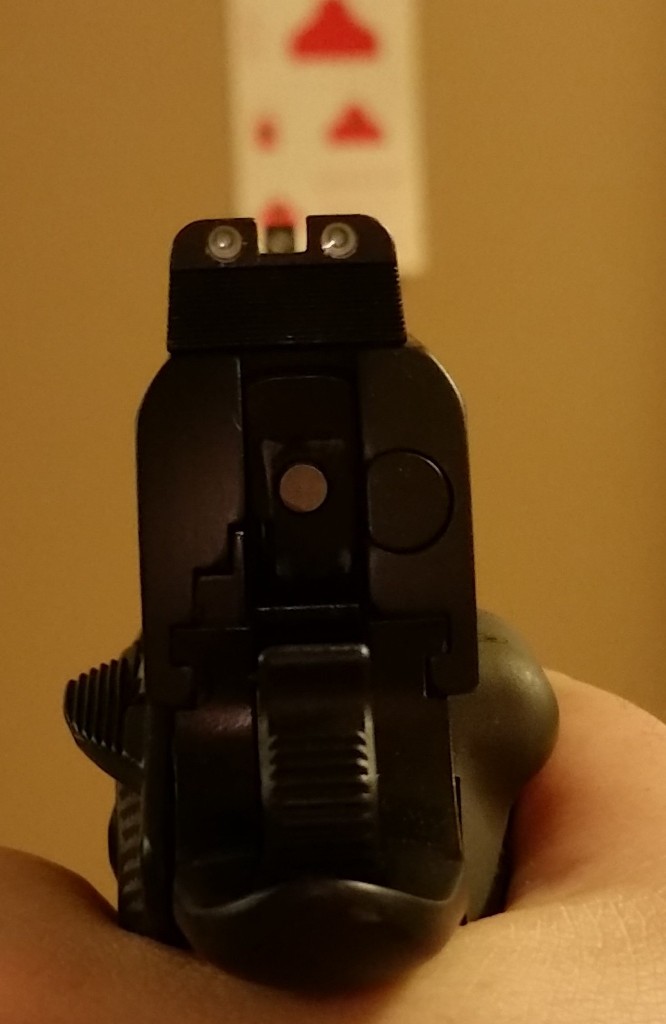
6 o’clock hold on small target with irons. Note how a center hold would block the entire target.
Reflex sights should be set for center hold. Lasers, which we haven’t discussed yet, should be set for center hold as well.
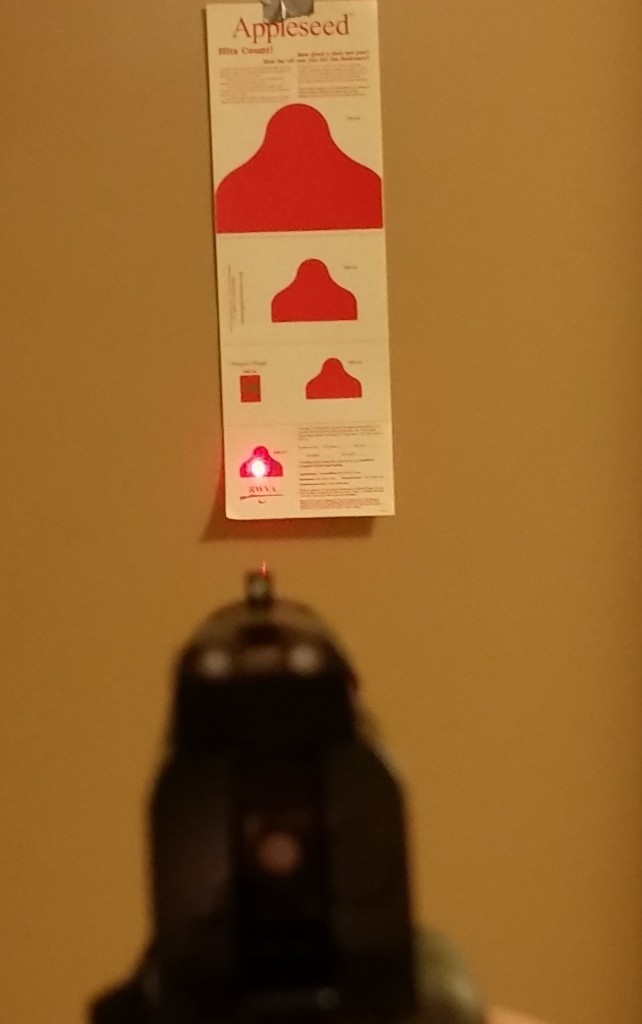
Lasers don’t need you (or the camera) to be lined up on the iron sights to work.
Sighting In
I teach riflery to new shooters and experienced ones. The experienced ones wonder why we do not adjust sights often until hours into the course. The reason is that it is much more important for you to put together a good shot group that is somewhere on the target than it is to adjust the sights.
It’s a question of accuracy versus precision. The Boy Scouts teach that accuracy is whether or not the group is centered on the bullseye, and precision is how tight the group is. Appleseed and Revere’s Riders teach that the software problems (your head and shooting) have to be fixed before the hardware (the sights of the gun.)
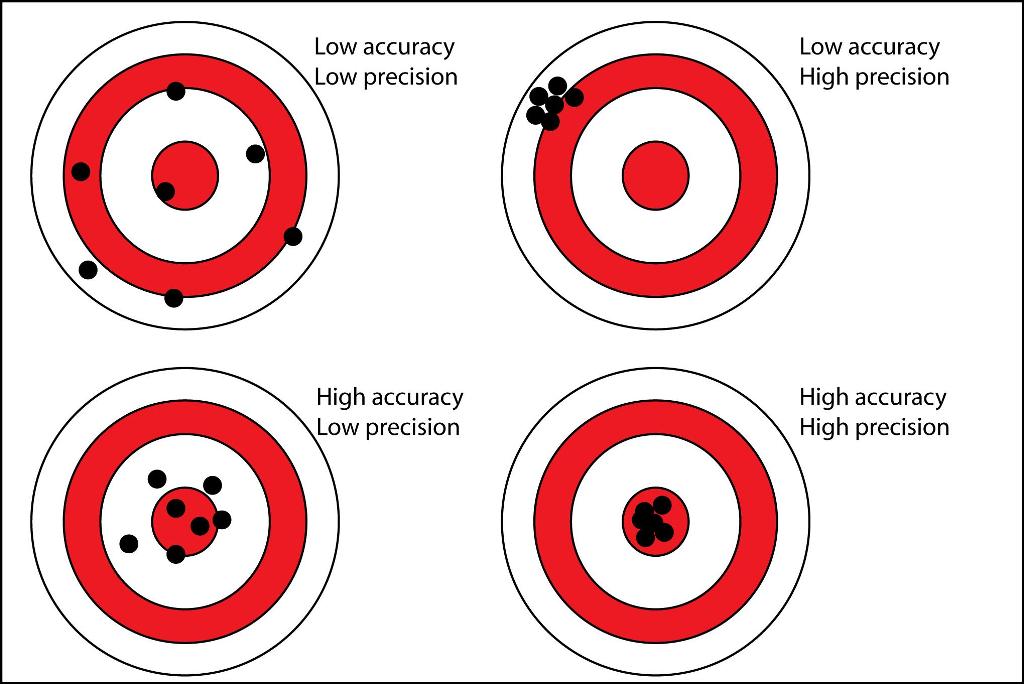
However, we will talk mechanical adjustments here briefly, and get into what we call IMC (Inches, Minutes, Clicks) in a future article. The simplest mechanical sight has a fixed front blade, and a fixed rear notch, and the gun shoots where it will. The next up is drift adjustable rear sights, and you tap (with a brass punch) them left or right (go the same direction as you want the bullet to go). Some rear sights have spring loaded wedges to raise them or lower them as needed.
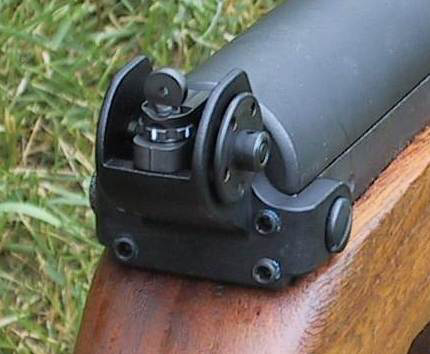
Adjustable mechanical sights can be “clicked” with a screwdriver or similar vertically and horizontally. Some front sights are also adjustable for height. The most advanced mechanical sights are “zeroable” which means you can set them to be on at a certain distance, and that will match an adjustable drum that you can turn to be on target at longer ranges. These sights also can be dialed in for wind compensation as well, and will be the subject of future articles.
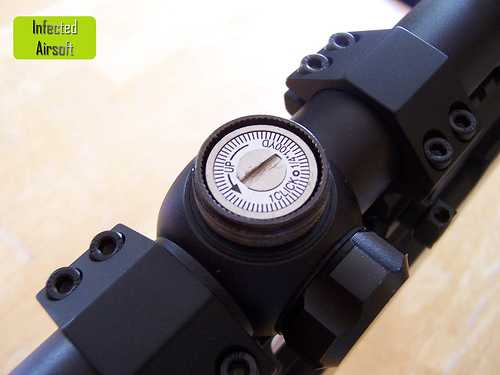
Scopes have click adjustable dials that can be used to move the crosshair to the bullet impact point at whatever range you want. This is “sighting in” and not “zeroing.” Zeroing, just like iron sights, requires you to set the sighting turret system to “zero” at whatever range you want, and most scopes are just able to be sighted in, not zeroed, unless you can move the turret separately.
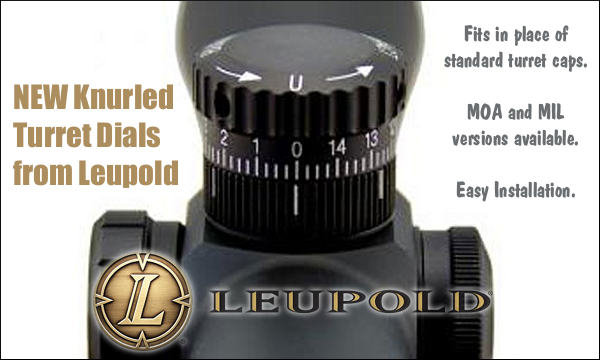
Conclusion
This should help with the fundamentals of aiming a rifle (and a pistol, and I guess a rifle-sighted combat shotgun, too.) In future articles, we’ll cover trigger control, IMC, ballistics, zeroing, and correction, as well as the basics of bullet and powder choices. Be safe.
Read More: 3 Things Cosmo Gets Wrong About Relationships With Men Who Own Guns.
Well written. I’ve been shooting rifles and shotguns since I was a wee lad, and these are the things I was taught and/or learned over that time.
It’s always best to learn these things under supervision. You don’t need to pay a marksmanship expert to learn these basic techniques, but you do want to start shooting with someone who has mastered them. Otherwise, you run the very real risk of developing bad habits that are hard to eradicate and inhibit your skill development.
As a personal example, my father had been shooting for almost forty years before he learned he was left-eye dominant. It took him two years to drill the old habits out, but his marksmanship improved dramatically once he had it.
héhé
For sure. A girl I know learned how to shoot from “some guy” at the range. With predicable results.
God! Worse thing white knights and hill billies can do is give guns to women.
Should you keep both eyes open when you aim down the sight?
I’ve never had any success shooting with my weak-eye open and don’t know anyone who has either. I’ve seen rifle shooters who can’t keep one closed use an eye-patch on their off eye.
Depends on the optics/site. HUD (not sure of the correct term, so using this) type sites you practically have to keep both eyes open for it to work correctly (red dots), such that you “lose” the actual HUD and only see the red dot and what it’s resting on. Irons I go weak eye closed most of the time though.
Thank you. I think I saw some movies a while back with snipers talking about keeping both eyes open was the correct way and thought I was doing it wrong. Not a big time shooter yet, only shot in the Boy Scouts as a lad, but when I move out of California I plan on getting some guns.
Straight irons I go closed, but scopes it depends on the scope and the eye relief available and the distance from my cheek rest. I also find both eyes open for tactical combat sidearms way more practical.
héhé
Mel Gibson told a generation of children to keep both eyes open when shooting.
And, “If the Road Warrior says it, it must be true!”
I usually take the opposite approach and close both eyes while shooting wildly in all directions. Think Yosemite Sam.
That’s a valid strategy when using a Grease Gun. Really, it’s the only way to not feel guilty about hitting random targets when you pull the trigger on that thing.
Stick to Tequila Bombs:
And keep clear of the dove poop
What’s the name of the Christian Bale movie where they have a style of martial arts for guns? I watched it a while back.
Equilibrium?
That’s it! Thanks. I enjoyed that movie.
exact
I would if you can, especially if we’re talking about personal defense at close distances like in the home.
We’ve got binocular vision for a reason, dat depth perception tho’
It varies for the shooter. Whatever helps. Some people close an eye; it bothers some people to close the eye. Some people prefer a black patch or some other total obstruction on glasses. Some don’t care. Some people like opaque. I had strabismus when I was born, and it was fixed, but I can let my non-dominant eye just look off at nothing partially because of it. My ophthalmologist, who is retiring, told me that I get eye shake when one eye is blocked and instead to have it blurred, not blacked out, when getting an exam. So, I guess I’d want an opaque thing like wax paper if I wanted something.
I keep both open. I’m left eye dominant and right handed so I turn my head a bit to shoot. If you actually have to use your pistol for defense it’s good to be more aware of what’s going on around you.
Great article. Personally I have good marksmanship with my AR, but I still suck with my pistol skills. I have heard that pistols are tougher to learn because of the shorter barrel and the fact that grip and trigger pull are roughly 80% of your accuracy. After shooting a pistol for 2 years and improving marginally I can’t watch Hollywood or television action heroes pull a gun and hit their targets on demand without yelling bullshit.
As for AR type rifles I would recommend practicing with your iron sight as much as possible. If you can hit targets at 300 meters with iron sights then using a scope later will make you a god. I run a red dot that is co-dependent on my iron sights with my AR-15. Co-dependent optics mean that the red dot sits on top of your front iron sight when viewing through the red dot lens.
I need more practice with my pistol, its part of the reason I got a 9mm, ammo is a touch cheaper to practice with.
You should look up some Jerry Miceluk videos on YouTube.
For me, pistols are harder, although I have more experience with them. I have a P226 that I’m pretty good with but when I try to use my S&W Shield, I can’t hit the broadside of a barn even if I was standing inside of it.
Funny enough I have a S&W M&P full size 9mm, I have a tough time being accurate with it. I think I am going to get the trigger replaced.
I have also thought about trading it in for a glock 9mm but I don’t want to run around trading and buying pistols to solve accuracy problems before I solidify my technique.
Seems like a lot of people love the M&P series, but hate the triggers. Are you hitting low and left with it?
Yes, I hit 7 and 8 o’clock all the time. So maybe my suspicions of a better trigger are spot on then?
My guns are always on target.
*flex*
I haven’t seen a pair of .17 Hornet rifles like that in a while. Neat.
Maybe try to adjust the posistion of your finger on the trigger first. Because my Shield has such a long, narrow grip, my hand moves the gun when I squeeze the trigger causing me to hit low and left. Even when I went from 115gr bullets to 124gr, I was still pretty off.
Ouch. Better than .177 air pellets though.
Bastard.
I was going to bring up Derringers, but I felt that you’d be sad and need a hug box, and we’re all out of those at the moment. Heh.
I’m triggered!
Do you still have any hug jackets in stock? If so, I’ll take one in mauve.
Boooo.
exact
LOL
LOL^^
héhé
exact my friend
The jokes…they must be done.
For some reason I can’t hit properly with Glocks. Even using these grip mods and such, even trigger mod. I just don’t like the grip angle and trigger.
Anything with a grip closer to a 1911 is what I shoot well with. I have friends who are the opposite.
I’d try shooting a few 10-20 round sets with a few different guns and just compare your grouping and centering like that. My guess is you will see big differences even if mechanically they are as accurate.
Friends of mine are into polymer guns and like spending tons on weird add ins and mods but they don’t seem to shoot better for it.
A Glock 22 was the first pistol I owned and for years I had the same problem. What made a huge difference was learning where the trigger reset was. Glocks have an awesome reset, short, audible, and you can feel it. If after a shot you only let up to the reset, you’ve got a much shorter and crisper trigger on round 2. Since learning better trigger control I can shoot about a million times better with them. Used to despise them, now I’m in the process of getting a G29 for my CCW pistol.
I have found that the CZ 75 SP-01 and the Beretta 92’s are two of the best pistols for accuracy, even if you aren’t very accurate with a pistol to begin with.
Sometimes people at the range allow you to try their firearms. Its a nice courtesy for others to offer. I’ll be on the lookout for your suggestions at the range. Gun range people are good people.
Just got my 92fs compact inox. Haven’t taken it to the range yet
Maybe because of its polymer frame? I had a buddy shoot a glock 19 and said the handling was “rough” wasn’t sure if he was indicating the grip ergonomics or recoil.
Could be, I shoot well with full metal guns, haven’t tried other polymer ones than a glock 17, but I fiddled the fuck out of that and never got to where I am easily with full steel.
I have the impression the felt impulse of the glock was weird, and the trigger pull was far to long stock. I shoot well from .22 up to .45 with steel guns, so it’s not amount of recoil.
But I can say honestly I think the glock grip is shit for me, doesn’t line up right and feels shifty on draw.
I have shot a long ass list of steel guns though, it could be just habit/learned stuff. One gun very few talk of is the FN 9mm HP-DA etc browning high power based ones. Really good guns overall, easy to use, clean, clear controls. Nothing really stands out but overall one of my faves.
héhé
Pistols are tough because the trigger pull weight is very close to the actual weight of the gun. Ex: 5 pound trigger on a 5 pound gun.
Good comment on movies…you hardly ever see good shooting fundamentals or any form of realistic firearms usage.
Check out John Wick for realistic shooting. Keanu put in serious work to train to shoot properly.
Unless you’re an NYPD officer, then its tough to shoot your pistol accurately with the mandated 12 lb DAO trigger pull
LOL 12 lb DAO triggerpull! Heh. That’s a hell of a pull!
I like the crisp clean trigger I put on my 1991A1 Series 80. Breaks neatly at 3.5 pounds. Very nice to shoot.
Yeah, when I heard it I couldn’t believe it and did some research and it’s true. Apparently its to lessen the likelihood of an inadvertent discharge while holding someone at gunpoint. But it explains why NYPD tends to miss in a gunfight, you really don’t want to be a bystander downrange…
Dayyyyum, that’s just stupid in a can, ain’t it?
The entire point of the safety system on DAO’s like Glocks is that they do NOT have inadvertent discharge if you keep your finger off of the safety release on the trigger. You can literally throw one at full force onto concrete, loaded, and the fucker will not go off. Hell you can do the same thing to a single action modern build 1911A1 and get the same non-discharge. The technology is quite sound. Keep the finger off the trigger unless firing, it should be a training issue only. 12 pounds of force will draw your barrel down, hard, and that does nobody any good.
But we’re talking NYC here, where gun knowledge is almost non-existent, especially among the political class.
Training and shooting regularly costs more than a simple mod to the hardware, so I think its a budget as well as a legal CYA thing.
They sell a ‘New York’ trigger for the Glock that Ayoob actually recommended at one time that raises the pull to 8 lbs. He recommends it for self-defense guns for legal reason- be able to testify you didn’t have a ‘ hair trigger’, in fact you’d raised it over the standard.
I’m going with a 6 lb trigger spring in a Glock Gen 3 knockoff build in .40S&W. (polymer80 frame with G35 Slide). I’ll see how I like the standard before changing it.
ETA- I do agree with you about hardware solutions to training problems. Even with the 12lb trigger, an NYPD officer shot someone in a stairwell inadvertent discharge incident.
exact my friend
LOL
That might offer an explanation for why the NYPD has shot so many bystanders.
This article really makes me want to learn how to shoot. Doesn’t seem likely living here though. I guess it’s for the best, like Homer Simpsons said: Every time I learn something new I forget something I used to know. Like that time I took a home wine making class and forgot how to drive.
In NYC, only the Government and Criminals are armed.
héhé
I hadn’t considered the relation between trigger pull and gun weight before.
Maybe there really are some advantages to the old single-action revolvers, which have “0 lb” trigger pull (at least, if you’re doin’ it like they did in the Westerns).
With a pistol it’s all about the grip. A good grip is isometric, it counters natural movement of one hand with natural movement of the other. Look up “thumbs foreword” grip technique. The key is to take your non shooting hand and angle it so the meat of your thumb rests in the space between your shooting hand’s thumb meat and fingers. It takes a lot of practice because it’s not an intrinsically natural feel.
Then repeat: “front sight, press” in your mind as you’re taking each shot. Focus on the front sight… press the trigger. Start slow.. develop fundamentals first… then you’ll get faster and faster to the point where you don’t have to think about it.
I recently adopted this technique in fact. Making it muscle memory from a holstered position is what i’m practicing now.
Get some dummy rounds (“dry fire rounds”) to drill with. I have a target on my wall that I train muscle memory with, and a magazine full of dry rounds ensures that I don’t accidentally discharge while practicing.
As a bonus, most of the rounds have similar weight to the real thing, so you aren’t temporarily surprised when pulling out a loaded gun.
Indeed, I began using “snap caps” mixed in with real rounds at the range. It was amazing to watch how i was compensating for the recoil when the snap cap was “fired”. I’m still learning to not anticipate the shot being fired. snap caps help with that for sure.
Pistols truly are a different animal to rifles.
As a note to the wise. I use a magazine painted safety orange with a full load of snap caps while practicing at home…this way you KNOW which mags you’re using. As always, safety first.
bioutiful army
For all SJW’s, there is a different technique that should be used, first place the barrel of the pistol in your mouth, then slowly squeeze the trigger.
pistol is dangerous
Why yes, yes they are. That’s why I own one.
To quote Larry Correia:
“why yes, I do carry a gun to compensate for my manhood. My penis is completely incapable of hurling a 230 grain lead projectile at 850 feet per second, and thus insufficient for self defense use.”
I have 2 words for Larry Correia. Kratom.
Kratom counts as two words now.
nice piece.
for anybody interested http://www.decisiveaction-us.com/
they give real world situation style training on using your gun in tight spots and tense situations. they’re great.
exact my friend^^
damn real. everybody knows how to aim a gun until a high stress situation hits, may as well get trained in high stress situations. especially as cheap as it is to take their classes.
no arme
A little off topic but, I’m a single issue voter, I only vote for pro gun candidates because anti gun candidates are always wrong about everything else too.
irony is a fucking bitch !
Most importantly: don’t learn to shoot from a web page. Get someone to teach you, otherwise you will most probably develop bad (and possibly dangerous) habits.
Good article. I offer to take many younger men shooting because it’s something that used to be past down from generation to generation. With the rise of single mothers, you no longer have younger men picking up this most valuable (and life saving) skill because too many mothers are afraid of guns and they teach their boys to be afraid of them.
It will be up to us to help train some of these younger men and steer them in the right direction.
side note: Glock 21 Gen 4 Nib X (Nibex finish) here
Since we’re showing off our guns:
H&K USP Compact 45
Beretta 92 FS Compact Inox Vertec with rail
I’m not interested in going to Dubai to be a doodoo ho.
Top right is a sight windage/elevation issue.
Bottom left is breathing and trigger execution.
I don’t think they’re actual groups; it’s an example to show what accuracy and precision mean.
Wait, lasers don’t need to be zeroed or aligned to the iron sights (on pistols)? I spent considerable amount of time adjusting my surefire
It’s a simple and complicated answer. The simple part is, yes, when you have the sights aligned to your head (you’re looking down them) and you turn the laser on, and you are at the distance you have sighted the gun at, the sights, the laser, and the bullet will all hit the same thing.
The complicated part is that, when your head is NOT aligned with the sights, like you’re holding the pistol at chest level, the laser will still be on target, and the sights will be, too, but you cannot use them until you move your head. The picture in the article shows us looking at the laser from above the gun, so the laser is accurate still, but we’re above the sights.
As for what to do, don’t zero the laser to the sights, zero it to the gun. Make sure the gun shoots accurately at the range you want, I typically set mine to 25 yards, with all sighting systems.
Decent article. How far men have fallen when we don’t even know how to shoot a gun. Far cry from the hardmen of the frontier that settled the USA. Hiliary Clinton save us all!
thumbs on one side. Find out what eye-dominance you are.
This is an amazing helpful article for anyone looking to get a suitable rifle scope. There are a plenty of rifle scope development Company making different series of optics with its unique features.As i am experience good a “http://riflescopereviewed.com/best-ar-riflescope-guide-reviews-4 ” which i recently bought from online after going through its specification out there.
This is an amazing helpful article for anyone looking to get a suitable rifle scope. There are plenty of rifle scope development Company making different series of optics with its unique features. As i am experience good a “bestariflescope” which i recently bought from online after going through its specification out there.